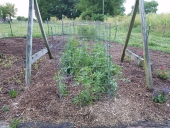There have been several mentions of silica in different posts, and honestly I attributed it to legend rather than science. Until I read some of Bryant Redhawk's posts about it. Put it this way, if he takes it seriously I take it seriously. I've spent a couple hours reading some hard science stuff about it but it is sparse.
It is not silica we are talking about any more than "nitrogen" in soil is gaseous nitrogen that makes up ~80% of the atmosphere. Silica is essentially inert, it is the oxide of the most common element in the crust. So something has to do some chemical work to make it incorporable in tissues (plant or animal). I don't know about human silica, it certainly appears to be a very minor component by dry
weight , but even small minerals have a critical role such as fluoride (gonna get beat up for that probably. The evidence I have seen is that well/spring water probably have adequate fluoride but municipal and softened probably don't. My suspicion is that water soluble silicates may be similar.
I would love to have some tough, bug resistant plants. I would love for those plants to give me some of this stuff as well, since I probably eat less dirt than people did historically. So that's the background.
I don't have horsetail, or nettles. I do have some bamboo, which is not on
this table, but is supposed to be a good source. I am trialling foliar feeding with a solution of minerals, humic acid, protein and sugar, so why not have some silicates in there if I can figure out how to solubilize them!







